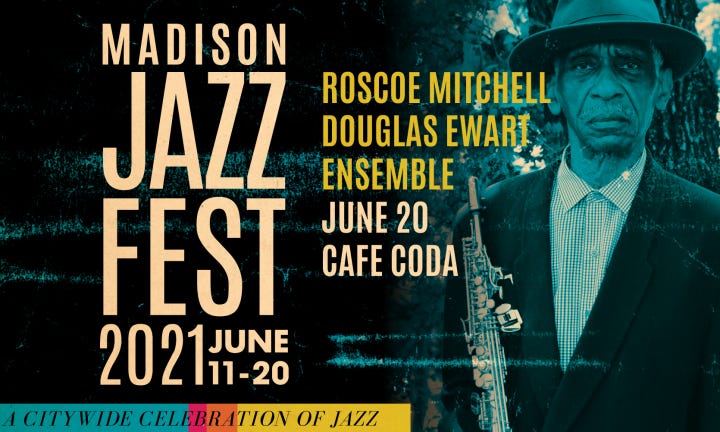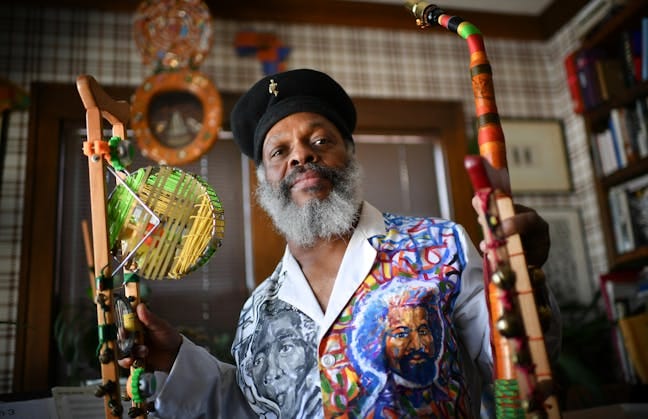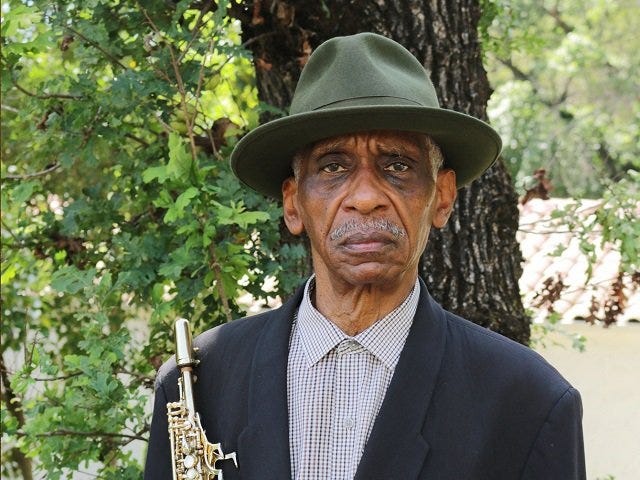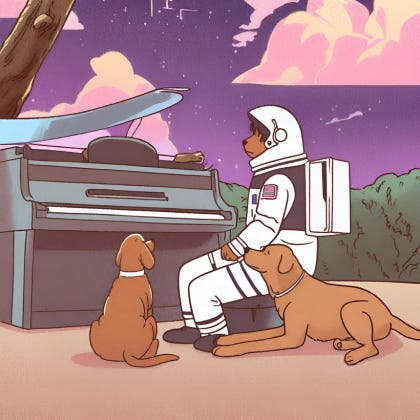Live performance review: The Roscoe Mitchell – Douglas Ewart Ensemble, featuring Junius Paul on bass and Vincent Davis on Percussion
A throwback review from the Madison Jazz Festival in 2021
This week my mind has been drawn to the past and reflecting on the places I used to call home. Thinking back to my time in Madison, Wisconsin, I thought it might be fun to brush up this past review of The Roscoe Mitchell - Douglas Ewart Ensemble, featuring Junius Paul on bass and Vincent Davis on Percussion.
This performance was on June 20th 2021, part of the then newly conceived Madison Jazz Festival, which consisted of a string of performances at Café Coda and the recently restored Garver Feed Mill in Madison in the early weeks of the summer of 2021. I lived near the Feed Mill at the time and had enjoyed the privilege of walking my dog and taking in free outdoor jazz performances throughout the events, so I decided to attend a performance to get a more complete experience.

Café Coda founder and proprietor Hanah Jon Taylor introduced the band. He started with a preamble, wishing everyone a happy Juneteenth. He spoke about the way jazz represents more than music. How music can never be separated from its time, and that music reflects what we are living as a society. He said something along the lines of, “The same thing that we are struggling for now is reminiscent of what we were struggling for in the Sixties. It’s not just music and entertainment and it’s not just art, it is the voice and spirit of the people, it is reflecting what we are living.”
Taylor’s words were poignant for the moment, setting the tone for the performance to come. I began to ruminate on his message, reflecting on the historical context of jazz and the tradition of jazz music, and the turmoil in American society over the prior five years, culminating in the pandemic in 2020. As the preamble came to a close and the musicians took the stage, a summer rain began to fall outside; softly playing off the roof with a steady, gentle rhythm.
With the stage set, the performance opened with a percussion piece. Douglas struck the singing bowl twice, and Roscoe opened with sparse and arrhythmic percussion on his uniquely assembled drum kit – built from a variety of unconventional items, including multiple wooden wind chimes, Bundt cake pans, Asian cymbals, African drums, glockenspiel, and various bells. He would also play an instrument that consisted of 7 Bundt pans on a staff. With their soft mallets steadily beating against their percussion instruments, the band built a rolling, tumbling sound that resembled a growing storm.
They were tapping into the energy of the moment, and a trance like hush fell over the audience as the rhythmic interplay, the antiphony of a global sampler of percussion drove onward. The piece reached its crescendo with Douglas creating the first instance of harmonic tone, producing a bow and beginning to draw it along the edges of the singing bowl, generating a ringing, intensifying hum. I had never seen a singing bowl used in such a way, and then came a rapid but subtle release, and the piece resolved into a scatter – the passing of the storm. The audience, excited to interact, erupted in a brief applause. The story of music continued to unfold.
It was then that the melodic instruments came into play. Douglas, on the soprano sax, would open the next piece, alternating long whole notes followed by silence of near equal length. Then, advancing into phrases of increasing complexity, they began incorporating elements of klezmer music and free jazz. Though their phrasing was disjointed and regularly employed harsh timbre and outside playing, the notes of the runs were still carefully selected and pleasing to the ear. I couldn't help but think of Albert Ayler's album Prophecy, especially “Ghosts” as the rest of the band joined in, with swells of cymbals, long bowed notes on the bass, and Ayler-esque howls.
It created a hauntingly beautiful, but at times, suffocating air. I began to squirm in my seat, struggling at moments to maintain the transcendence of disbelief as the piece began to boil over beneath an overwhelming, unresolving tension. As the massive bell of the baritone sax bellowed out, demanding attention, the disjointed nature of the music shifted, finally giving way. I gazed into the void of the saxophone, listening, once again adrift. This time to a place that felt somewhat metaphysical and hard to define.
I found myself reflecting on the construction of free jazz. How it takes collective improvisation to the extreme, with each member of the band having a loose road map but entirely in their own world. Contributing not to a harmonic or rhythmic structure per se, but more to a communication of thought and feeling within a particular realm. It feels a lot like the internal monologue, exhausted with traditional structure and just left to fly freely. Free jazz feels more like communicating in images and feelings than in words. Telepathy. It feels like a music that is not afraid to be ugly if it means telling the truth of the story, and I find that to be its best quality. As I drifted in my thoughts, the first set came to a close and there was a brief intermission.
Both sets had a rolling, arrhythmic feel throughout. The band was absolutely masterful at the use of tension and release. While free jazz can often be challenging or even confrontational, they managed the energy well and created a unique ambience that I found driving me inward, toward deep introspective thought. It was clear that they were devout students of Ayler and Coltrane. They made generous use of overblown notes and vocal sounds that resembled shrieks and cries, employing a totally free use of rhythm and highly irregular phrasing. The music was driven by motivic themes and made cogent use of outside playing. The performance was deeply conceptual, and each set felt more like one extended piece with 3 or 4 movements rather than a series of songs.
Though the music was formless in many ways, a structure was imposed by turn-based soloing, and the dynamic range of the rhythm section. There were generally two active leading instruments in pairs, embracing a sort of disjointed antiphony at any given moment, with the other two either holding back and listening, or adding long hanging notes to add to the tension. Throughout the performance, each member of the band would get a chance to lead, which helped to establish a dialogue within the sound and enhance the dynamic flow of the music.
The band maintained what I would describe as a state of accessible mystery. They checked in with the audience to make sure they were connecting, but did not attempt to be overly familiar or share long stories. Douglas had an attention grabbing look that gave him a certain “Master of Ceremonies” air. He wore a white coat with the faces of significant figures in recent civil rights struggles painted on the front, and a beret, but with a more militaristic look than the ones commonly thought of on Dizzy Gillespie’s head. The garb of a soul doctor, a shaman of light and sound, a revolutionary.

The rest of the band took a more classic look of the updated 1920s aesthetic, with slacks, suspenders, and a suit jacket and hat for Roscoe. The long form pieces made for less interaction with the audience throughout, which I felt contributed to the atmosphere of a free jazz performance. I think it’s important to create a consistent vibe with such conceptual music – to create a suspension of disbelief, and the group did so expertly. It was apparent through the nonverbal communication of the group when the transitions would come, usually with some sort of physical gesture. Though often, the cues appeared to be musical or imperceptible. It was clear the group chemistry was high, and that the players understood each other well. Modern and classic, united as one.

There was a pervasive tumbling feeling, with the first set having a darker feeling and the second set more evoking the feeling of light and renewal. The second set opened with Roscoe on the Baritone Sax and Douglas joining in on the digeridoo. The two deep voices of the instruments blended into one and separated freely as each player took runs or added accents, intimating an effect of throat singing. Slowly with the growing inclusion of more "falling sounds" from percussion, bells and chimes were hit to punctuate the shifting energy of the piece, shifting as themes shifted between the leading melodic instruments. The second set embodied even more the structure of existing as one long musical piece, with the rhythm section maintaining an absolute fever pitch of athletic playing throughout.
The cosmic aura of Sun Ra would emerge with a spoken word section from Douglas, “the fate of things, the shape of things, the shaping of things, are you being shaped?” He would continue to flow, “They came with songs and dances of sun life, they danced to keep the planets aligned, they danced to keep death away, they came from the Sun with songs of sun life, played drum flutes, they played drum flutes…” The music had taken on a new air and heat and intensity. If the first set was evoking the rain, the second set was evoking the sun to come from the storm, and the ongoing struggle of dark and light.
The music was still very turbulent. I felt like I was listening to the sound of the mind negotiating the confusion of existence, the traumas, the joys, and the flights of fancy. The overall arc of the set had finally gone from tension to release, and as Roscoe played his sax you could feel everything pouring out. There was an electricity among the audience as we applauded in the spaces, to let them know we wanted to be there with them, that we were there with them, as close as we could be.
In many ways, I felt their sets told the story of jazz. From its tribal origins to it’s high minded and most conceptual ends. Revolution was the thesis of the performance, as clearly stated by the spoken word section in the second set, which I felt was as much a treatise of jazz in itself, “Its time for a perpetual awakening. Wake up. There is no such thing as truth to power. Truth is power.”
We are long overdue for such an awakening. I would advise anyone looking for a bit of spiritual cleansing (or maybe just a bit of cosmic dentistry) to dive in below (headphones on)…


